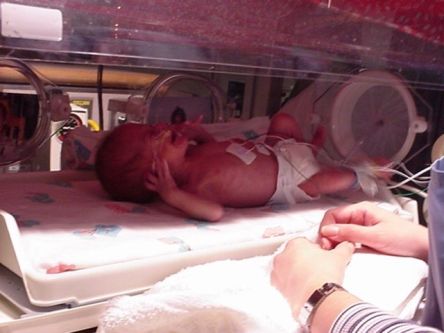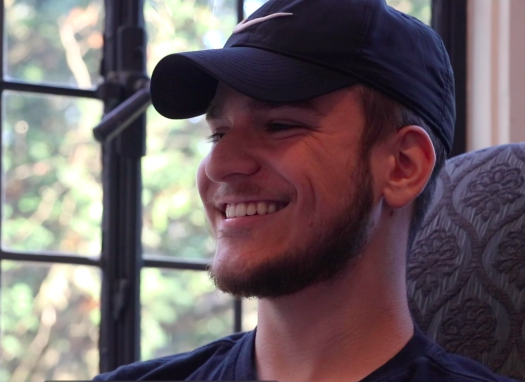Cabrini freshman Thomas Ryan looks like an average freshman. But his story, even before he was born, was one for the record books. He was one of the earliest cases of an embryo discovered to have spina bifida and to receive an operation before he was born. Here’s his story.
Sitting across from him, you would never know Ryan was born with Spina Bifida Myelomeningocele.
“A lot of people don’t think I have it. It’s an invisible disorder,” Ryan said.
WHAT IS SPINA BIFIDA
Spina Bifida is a birth defect that occurs when the spine does not form properly. Part of the spinal cord and nerves are exposed through an opening of the back.
Ryan’s mother had a late screening for her pregnancy offered by the doctors and that’s when she found out Ryan had spina bifida. After Ryan’s mother won a “raffle” for this procedure, she became the 26th participant at CHOP to have this surgery done with the baby still in the womb.
Spina bifida is the most common central nervous system birth defect. It occurs 1 in 2,000 live births in the United States. Similarly, 1,500 babies in the U.S. each year are born with spina bifida.
There are different types of spina bifida: Occult Spinal Dysraphism (OSD), Spina Bifida Occulta, Meningoele and Myelomeningocele. Ryan has Myelomeningocele (MMC), the most debilitating form of spina bifida. Myelomeningocele is caused by genetic and micronutrients factors.
According to CHOP, Myelomeningocele is the condition in which part of the spinal cord and surrounding nerves push through the open bones in the spine and projects out of the baby’s back. The projected spinal cord is contained in a sac that is defenseless against amniotic fluid. If the spinal cord is exposed to amniotic fluid for a long period of time, it’s more likely to result in progressive neurological injury.
Many children who are born with spina bifida can end up depending on breathing tubes, trach tubes, wheelchairs, and have a difficult time being able to talk and may have leg braces.

THE PROCEDURE
Ryan is one of about 361 babies at CHOP to have had a fetal surgery for spina bifida. The surgery consists of opening the mother’s uterus, flipping the baby over so their back is exposed, fixing the baby’s spine and sewing the mother back up. There is currently no cure for spina bifida.
The surgery was experimental in the sense that the doctors wanted to see the effects of the surgery later in life, but most women are advised to go through with the surgery because it has the best outcome for a child’s life who has spina bifida.
Ryan said his mother handled the news of her child having spina bifida well but noted she was surprised and distraught because she didn’t know what it was. “She did a lot of her own research, kept a level head and prayed with my dad and older sisters,” Ryan said.

FOLLOW-UP PROCEDURE
With every child the amount of surgery needed throughout their life is different. Everything in the spinal cord and the growth plates become pent up, so doctors have to release the tension in the spinal cord.
Ryan had another surgery done sophomore year of high school and was in the hospital for 11 days and wasn’t able to get up out of bed for 23 hours each day. The recovery was also lengthy as Ryan lost 12 pounds of muscle and was in physical therapy for three months.
Going through this made Ryan put his birth defect into perspective.
“It made me emotional towards the parents who have younger children with spina bifida who have had 60 surgeries and they’re only 10 years old. It is challenging to see that and not want to make a difference,” Ryan said.
STRUGGLES ALONG HIS JOURNEY
Growing up, Ryan had development issues and still does to this day. When he was younger he wasn’t potty-trained at the same age as the other kids, took a long time to get from crawling to walking and had to use a walker because his legs were not strong enough to support his body.
Although Ryan has physical disabilities, that never bothered him. Instead it’s the mental aspect that he struggles with.
“The only thing that has affected me through this whole journey is that mental barrier, of fitting into my own standards but also fitting into being accepted by society,” Ryan said. “It gets hard, it gets difficult sometimes because I know that I’m different and I’ve accepted that I’m different but at times it’s just why me?”
HIS SUPPORT SYSTEM
Ryan has had friends who he has known for 18 years who were the only ones to stick by his side throughout his whole journey. “They motivate me and don’t let me stick out like a sore thumb. They make me feel like I’m one of them,” Ryan said.
Ryan becomes emotional as he talks about how his family has supported him through all this. Teary eyed, he said, “My mom has been through everything imaginable and is amazing– there’s no other way to explain it, my dad sacrificed a lot; he’s given up so much and I have such a good connection to my sisters; they have guided me through so many different things and pushed me to be the best version of myself.”
“I’m thankful for everything they [my family] do. Receiving news that your child has this is a lot to handle, let alone carrying out a life with a kid who has spina bifida,” Ryan said.
HOW HE WANTS TO HELP OTHER CHILDREN
Ryan aspires to be a child life specialist and became passionate about this when he was in the hospital during high school.
“I talked with them and the attitude they had towards their job and the passion they portrayed their work is something I looked up to, it made me think ‘that’s the person I want to be when I grow up,'” Ryan said.
MOVING FORWARD
Ryan said that his birth defect has changed his outlook on life because he doesn’t take a lot for granted and the things he does take for granted, he sees in other people who have the same condition as him who are much more debilitated.
He is passionate about spreading awareness of this birth defect and wants to show people with spina bifida that it is okay to be different and that you will be accepted.
Ryan says he thinks he is a leader in that sense because he is very open about it [spina bifida] and is willing to speak up which most people are not able to do because they feel like if they do, they’ll be looked at as different.
He continues to be saying the work he has done and the examples he has set has paid off and made an impact on other people’s lives.

“I’ve accepted that I’m different. I always use the quote, ‘It’s okay to be different but not to be treated as though you are different.’ For me, it’s always been about being equal to my standards and fitting into the standards I set for myself and not the standards society sets for me. How I live my life is portrayed through the miracle that has happened to me, and that I’ve been blessed with.”


